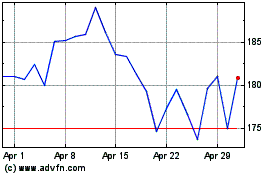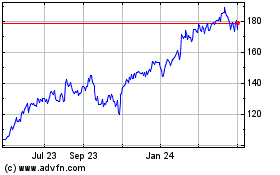New service allows customers who build
scientific and engineering models to quickly and easily set up and
manage high performance computing infrastructure to accelerate
R&D at scale
Marvel Fusion, Maxar, RONIN, and The National
Renewable Energy Laboratory among the first customers and partners
to use AWS Parallel Computing Service
Amazon Web Services, Inc. (AWS), an Amazon.com, Inc. company
(NASDAQ: AMZN), today announced the general availability of AWS
Parallel Computing Service, a new managed service that helps
customers easily set up and manage high performance computing (HPC)
clusters so they can run scientific and engineering workloads at
virtually any scale on AWS. The service makes it easy for system
administrators to build clusters using Amazon Elastic Compute Cloud
(Amazon EC2) instances, low-latency networking, and storage
optimized for HPC workloads. With AWS Parallel Computing Service,
scientists and engineers can quickly scale simulations to validate
models and designs, while system administrators and integrators can
build and maintain HPC clusters on AWS using Slurm, the most
popular open-source HPC workload manager. This service accelerates
innovation in areas such as fast-tracking drug discovery,
uncovering genomic insights, building engineering designs, running
weather applications, and building scientific and engineering
models. To get started with AWS Parallel Computing Service, visit
https://aws.amazon.com/pcs/.
AWS has a history of innovation in supporting HPC workloads.
That history includes releases like the open source cluster
orchestration toolkit AWS ParallelCluster, fully managed batch
computing service AWS Batch, low latency network interconnect
Elastic Fabric Adapter, Amazon FSx for Lustre high performance
storage, and dedicated AMD, Intel, and Graviton-based HPC compute
instances, the latter delivering up to 65% better price-performance
over comparable compute optimized x86-based instances. Thousands of
customers from a wide range of industries have migrated their HPC
workloads to AWS to fast-track drug discovery, uncover genomic
insights, maximize energy resources, and spin up supercomputers
with millions of cores. Today AWS continues our innovation in HPC
by releasing a fully-managed and comprehensive HPC service, which
removes the undifferentiated heavy lifting of creating and managing
HPC clusters.
AWS Parallel Computing Service is a new managed service that
helps customers easily set up and manage HPC so they can run
scientific and engineering workloads at virtually any scale on AWS.
With AWS Parallel Computing Service, system administrators can use
familiar tools including AWS Management Console, CLI, and SDK to
deploy a managed Slurm environment. AWS Parallel Computing Service
builds from open-source foundations that customers know and have
experience with, and delivers a managed Slurm experience with the
reliability and availability of AWS. AWS Parallel Computing Service
significantly reduces the operational burden of managing a cluster
and regularly delivers new capabilities and fixes through managed
service updates with minimal to no downtime, eliminating the need
to apply manual patches and rebuilding clusters to receive feature
updates. Highly available APIs also help developers and ISVs create
end-to-end HPC solutions on top of AWS, so they can focus on
providing value-added features to their users and customers instead
of worrying about managing infrastructure. AWS Parallel Computing
Service enables customers of all sizes (e.g., startups,
enterprises, or national labs) to easily create and manage HPC
clusters with the scalability, reliability, and security of AWS.
This means scientists and engineers using Slurm can easily migrate
their existing on-premises workflows to AWS without re-architecting
them—giving scientists and engineers access to cloud infrastructure
that scales automatically. And administrators who want to unblock
capacity or capability constraints for their end-users can spin up
clusters in just minutes instead of months, to run their
simulations to address the world’s most challenging problems.
“Developing a cure for a catastrophic disease, designing novel
materials, advancing renewable energy, and revolutionizing
transportation are problems that we just can’t afford to have
waiting in a queue,” said Ian Colle, director, advanced compute and
simulation at AWS. “Managing HPC workloads, particularly the most
complex and challenging extreme-scale workloads, is extraordinarily
difficult. Our aim is that every scientist and engineer using AWS
Parallel Computing Service, regardless of organization size, is the
most productive person in their field because they have the same
top-tier HPC capabilities as large enterprises to solve the world’s
toughest challenges, any time they need to, and at any scale.”
To get started, system administrators use the AWS Management
Console to spin up a Slurm cluster securely and execute jobs in
just a few clicks, compared to manual orchestration today. With
CloudFormation support coming soon, customers will be able to build
and deploy HPC clusters using infrastructure as code. AWS Parallel
Computing Service is now available in the following Regions: US
East (Ohio), US East (N. Virginia), US West (Oregon), Europe
(Frankfurt), Europe (Stockholm), Europe (Ireland), Asia Pacific
(Sydney), Asia Pacific (Singapore), Asia Pacific (Tokyo).
Marvel Fusion is a Germany-based fusion energy startup pursuing
the creation of unlimited zero-emission energy. “We are excited
that AWS Parallel Computing Service will deliver highly available
and easy-to-upgrade HPC cluster management capabilities,” said
Moritz von der Linden, CEO of Marvel Fusion. “It will empower our
scientists and IT staff to take advantage of the latest AWS
Parallel Computing Service capabilities in hours, instead of the
weeks of planning and overhead previously needed.”
Maxar Intelligence provides secure, precise geospatial
intelligence, enabling government and commercial customers to
monitor, understand, and navigate our changing planet. “As a
long-time user of AWS HPC solutions, we were excited to test the
service-driven approach from AWS Parallel Computing Service,” said
Travis Hartman, director of Weather and Climate at Maxar
Intelligence. “We found great potential for AWS Parallel Computing
Service to bring better cluster visibility, compute provisioning,
and service integration to Maxar Intelligence’s WeatherDesk
platform, which would enable the team to make their time-sensitive
HPC clusters more resilient and easier to manage.”
RONIN is an Australia-based software company whose flagship HPC
service provides a simple, intuitive web interface for researchers
and scientists from leading academic and research institutions to
easily run HPC simulations on AWS. "Democratizing HPC in the cloud
by simplifying the user experience for researchers is our key
mission," said Nathan Albrighton, CEO and founder of RONIN. "The
introduction of AWS Parallel Computing Service greatly simplifies
our ability to build and operate HPC environments using APIs and
elevates the HPC capabilities we offer to our customers."
The U.S. Department of Energy’s National Renewable Energy
Laboratory (NREL) is a leading institution focused on research,
innovation, and strategic partnerships to deliver solutions for a
clean energy economy. "The pursuit of scientific discovery comes
with significant overhead associated with maintaining high
performance computing infrastructure," said Michael Bartlett, cloud
architect in the Advance Computing Operations Group at NREL. "AWS
Parallel Computing Service has the potential to improve our
research efficiency by reducing this overhead with its automated
update and observability management features. In particular, new
capabilities for automatic scaling and handling high-throughput
computing tasks will allow us to efficiently process large datasets
and complex simulations, ensuring that our scientists can
prioritize solving high-priority problems."
About Amazon Web Services
Since 2006, Amazon Web Services has been the world’s most
comprehensive and broadly adopted cloud. AWS has been continually
expanding its services to support virtually any workload, and it
now has more than 240 fully featured services for compute, storage,
databases, networking, analytics, machine learning and artificial
intelligence (AI), Internet of Things (IoT), mobile, security,
hybrid, media, and application development, deployment, and
management from 108 Availability Zones within 34 geographic
regions, with announced plans for 18 more Availability Zones and
six more AWS Regions in Mexico, New Zealand, the Kingdom of Saudi
Arabia, Taiwan, Thailand, and the AWS European Sovereign Cloud.
Millions of customers—including the fastest-growing startups,
largest enterprises, and leading government agencies—trust AWS to
power their infrastructure, become more agile, and lower costs. To
learn more about AWS, visit aws.amazon.com.
About Amazon
Amazon is guided by four principles: customer obsession rather
than competitor focus, passion for invention, commitment to
operational excellence, and long-term thinking. Amazon strives to
be Earth’s Most Customer-Centric Company, Earth’s Best Employer,
and Earth’s Safest Place to Work. Customer reviews, 1-Click
shopping, personalized recommendations, Prime, Fulfillment by
Amazon, AWS, Kindle Direct Publishing, Kindle, Career Choice, Fire
tablets, Fire TV, Amazon Echo, Alexa, Just Walk Out technology,
Amazon Studios, and The Climate Pledge are some of the things
pioneered by Amazon. For more information, visit amazon.com/about
and follow @AmazonNews.
View source
version on businesswire.com: https://www.businesswire.com/news/home/20240828173857/en/
Amazon.com, Inc. Media Hotline Amazon-pr@amazon.com
www.amazon.com/pr
Amazon.com (NASDAQ:AMZN)
Historical Stock Chart
From Dec 2024 to Jan 2025

Amazon.com (NASDAQ:AMZN)
Historical Stock Chart
From Jan 2024 to Jan 2025
